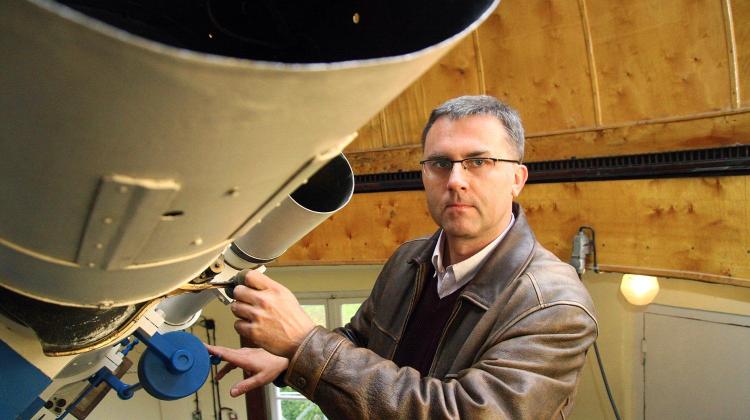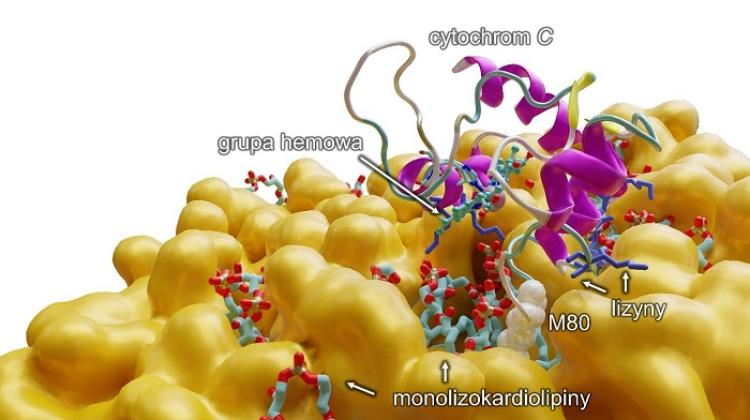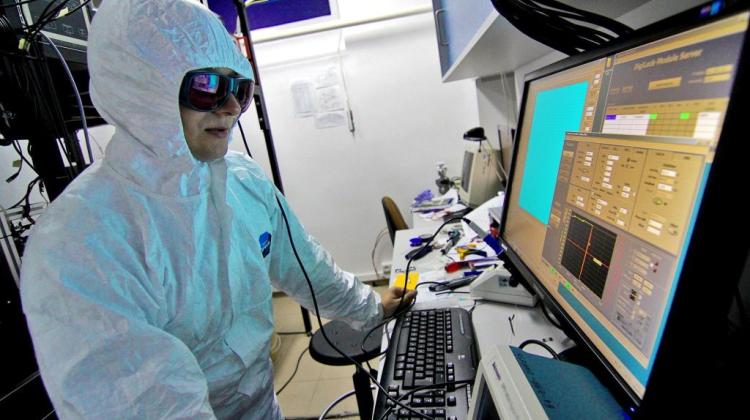Polish astronomers discover another extrasolar planet
 Prof. Andrzej Niedzielski at one of the Nicolaus Copernicus University Centre for Astronomy telescopes. Photo: Andrzej Romański / UMK.
Prof. Andrzej Niedzielski at one of the Nicolaus Copernicus University Centre for Astronomy telescopes. Photo: Andrzej Romański / UMK.
A team composed mostly of Polish astronomers from Nicolaus Copernicus University in Toruń discovered two objects in the vicinity of a distant star about 230 light years from Earth. These objects are a planet similar to Jupiter and a brown dwarf.
This is the fourteenth planet discovered by the group led by Prof. Andrzej Niedzielski.
The discovery is the result of an observation project conducted for 10 years with a 9.2-meter Hobby-Eberly Telescope (HET) in Texas, recently supported by observations with a 3.58-meter Telescopio Nazionale Galileo (TNG) in the Canary Islands. Research team is headed by Prof. Andrzej Niedzielski of Nicolaus Copernicus University in Toruń. In the case of the first telescope, cooperation is conducted with Prof. Aleksander Wolszczan of Pennsylvania State University, and observations with the second telescope are carried out in cooperation with Eva Villaver of the Autonomous University of Madrid.
Astronomers observed the star with designation TYC 1422-614-1, which is located about 233 years light away. The star has a mass similar to the Sun (about 15 percent greater), but much larger dimensions - up to seven times exceeding the diameter of the Sun. TYC 1422-614-1 is evolutionarily more advanced than the Sun, it is one of the objects astronomers call red giants. Our Sun will also be in the red giant phase in a few billion years, it will increase its size and perhaps reach Earth\'s orbit. In turn, the red giant TYC 1422-614-1 also will further increase its radius and in about 120-130 million years it will absorb its planets.
The stars TYC 1422-614-1 can not be seen with the naked eye because of its brightness in the night sky is a 10 magnitude. But it is in the range of small telescopes - you can see it in the constellation Leo.
According to Prof. Niedzielski, closer to the star, at a distance of 0.69 AU, is the planet "b" with a mass of 2.5 Jupiter masses, and on a more extensive orbit, at a distance of 1.37 AU, revolves the body "c" with a mass of 10 Jupiter masses. If placed in our solar system, the newly discovered objects would be approximately in orbits of Venus and Mars. These planets are, however, much more massive than those in the solar system.
"The object TYC 1422-614 c is so massive that it probably is not a planet, but a so-called brown dwarf" - said Niedzielski.
Brown dwarfs are a category of objects between planets and stars. Sometimes they are called "failed stars". They have masses larger than planets, but they are too small to initiate nuclear fusion synthesis of hydrogen into helium and thus become a star. These objects are, however, capable of deuterium synthesis, which distinguishes them from planets.
According to the researchers from Nicolaus Copernicus University, TYC 1422-614 is the second most evolved among the known planetary systems. The first was also discovered by Toruń astronomers (by the star BD+20 2457). In addition, it is one of the few systems that has both a planet and a brown dwarf.
In addition, the researchers speculate that the planet in this system for about 4 billion years was at a distance from its star that allowed for the presence of water in the liquid state on the surface. Since, however, it is probably a gas planet (like Jupiter) and not rocky (like Earth), places with the potential for the development of life could be on the moon of the planet, if it had one.
The publication describing the research results was published in the January issue of the scientific journal "Astronomy & Astrophysics".
The full list of the research team members: Prof. Andrzej Niedzielski (NCU), Eva Villaver (Universidad Autónoma de Madrid), Prof. Aleksander Wolszczan (Pennsylvania State University), Monika Adamów (NCU), Kacper Kowalik (NCU), Dr. Gracian Maciejewski (NCU), Dr. Grzegorz Nowak (Instituto de Astrofísica de Canarias in Tenerife and NCU), Anibal García-Hernández (Instituto de Astrofísica de Canarias, Tenerife), Beata Deka (NCU) and Michalina Adamczyk (NCU).
PAP - Science and Scholarship in Poland
cza/ mrt/
tr. RL
Przed dodaniem komentarza prosimy o zapoznanie z Regulaminem forum serwisu Nauka w Polsce.


















